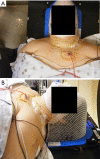Prophylactic external beam radiation therapy for keloid prevention in thyroid surgery patients
- PMID: 33633963
- PMCID: PMC7882325
- DOI: 10.21037/gs-20-511
Prophylactic external beam radiation therapy for keloid prevention in thyroid surgery patients
Abstract
Background: Poor cosmesis, secondary to keloid or hypertrophic scar, following thyroid surgery may cause considerable patient distress and be a significant challenge to treat. In this case series we examined the efficacy of prophylactic external beam radiation therapy (EBRT) for prevention of keloid formation in keloid-prone patients undergoing thyroid surgery. While much has been published about documenting the efficacy in reducing keloid formation following keloid excision, very little literature exists documenting prophylactic use related to surgeries with the goal of prevent de novo keloid formation.
Methods: We retrospectively evaluated a series of ten patients, who underwent a prophylactic EBRT for keloid prevention after thyroid surgery between January 2013 and February 2019. Patient demographics, primary diagnosis, surgical procedure, EBRT dosage, and post-operative visit records were reviewed.
Results: All ten patients who received EBRT for keloid prophylaxis following a thyroid surgery were female. Half of the patients were African Americans, 40% Caucasians, and 10% Hispanic. The mean age was 46.40±15.63 years with BMI of 31.5±5.5 kg/m2. Radiation was initiated within 6 hours of the surgery with an average radiation dose per session of 5.7±1.7 Gy. The total average EBRT dose delivered was 17.4±4.2 Gy. Mean follow-up period was 13 months post-thyroidectomy, with the longest follow-up at 23 months. One patient, who underwent a lateral neck dissection in addition to thyroid surgery, developed hypertrophic scar in less than 10% of her incision length. Nine other patients (90%) showed no post-surgical keloid nor hypertrophic scar formation and patients were satisfied with postsurgical cosmesis.
Conclusions: We examined the efficacy of prophylactic EBRT in keloid-prone patients undergoing thyroid surgery. Prophylactic EBRT following thyroid surgery is effective in achieving a satisfactory cosmetic outcome in patients at high risk for keloid formation.
Keywords: Thyroid surgery; external beam radiation; keloid; neck surgery; radiation therapy.
2021 Gland Surgery. All rights reserved.
Conflict of interest statement
Conflicts of Interest: All authors have completed the ICMJE uniform disclosure form (available at http://dx.doi.org/10.21037/gs-20-511). EK serves as an Editor-in-Chief of Gland Surgery. The authors have no other conflicts of interest to declare.
Figures
Similar articles
-
Surgical Excision and Adjuvant Brachytherapy vs External Beam Radiation for the Effective Treatment of Keloids: 10-Year Institutional Retrospective Analysis.Aesthet Surg J. 2017 Feb;37(2):212-225. doi: 10.1093/asj/sjw124. Epub 2016 Aug 23. Aesthet Surg J. 2017. PMID: 27553611
-
Robot-assisted Sistrunk's operation, total thyroidectomy, and neck dissection via a transaxillary and retroauricular (TARA) approach in papillary carcinoma arising in thyroglossal duct cyst and thyroid gland.Ann Surg Oncol. 2012 Dec;19(13):4259-61. doi: 10.1245/s10434-012-2674-y. Epub 2012 Oct 16. Ann Surg Oncol. 2012. PMID: 23070784
-
High-dose-rate interstitial brachytherapy vs external beam radiation for the treatment of complex keloids.Med Dosim. 2022 Summer;47(2):158-160. doi: 10.1016/j.meddos.2022.01.003. Epub 2022 Mar 7. Med Dosim. 2022. PMID: 35264302
-
Assessing keloid recurrence following surgical excision and radiation.Burns Trauma. 2020 Nov 14;8:tkaa031. doi: 10.1093/burnst/tkaa031. eCollection 2020. Burns Trauma. 2020. PMID: 33225004 Free PMC article. Review.
-
A Retrospective Registry Study Evaluating the Long-Term Efficacy and Safety of Superficial Radiation Therapy Following Excision of Keloid Scars.J Clin Aesthet Dermatol. 2020 Oct;13(10):12-16. Epub 2020 Oct 1. J Clin Aesthet Dermatol. 2020. PMID: 33584951 Free PMC article. Review.
Cited by
-
Role of Prehabilitation and Rehabilitation on Functional Recovery and Quality of Life in Thyroid Cancer Patients: A Comprehensive Review.Cancers (Basel). 2023 Sep 10;15(18):4502. doi: 10.3390/cancers15184502. Cancers (Basel). 2023. PMID: 37760472 Free PMC article. Review.
References
-
- Danielsen PL, Ru W, Agren MS, et al. Radiotherapy and corticosteroids for preventing and treating keloid scars (Protocol). Cochrane Database Syst Rev 2013;(12):CD010883.
LinkOut - more resources
Full Text Sources
Other Literature Sources


